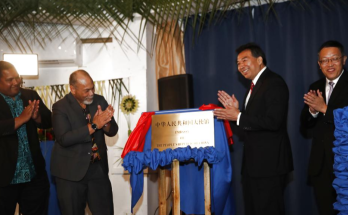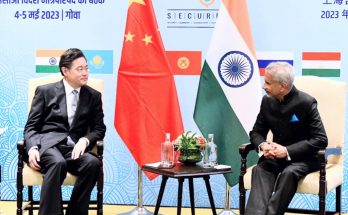 India and China are poised to hold their first round of boundary talks since the formation of the Narendra Modi government in New Delhi – a key round of discussions that could see some movement ahead of the Indian leader’s much-awaited visit to Beijing in May this year.
India and China are poised to hold their first round of boundary talks since the formation of the Narendra Modi government in New Delhi – a key round of discussions that could see some movement ahead of the Indian leader’s much-awaited visit to Beijing in May this year.
China’s Special Representative for boundary talks, State Councillor Yang Jiechi, a former foreign minister, will hold talks with his Indian counterpart, National Security Adviser Ajit Doval, in New Delhi on March 23-24.
Optimistic, but uphill climb
Having already met on the sidelines of the Munich Security Conference in February, the two Special Representatives are going to be looking at ways and means to sustain the momentum in the India-China relations that has built up over the past year, with Chinese Xi President Jinping’s visit to Delhi in September 2014 and India’s Foreign Minister Sushma Swaraj’s visit to Beijing last month. Ostensibly, there is a desire to break new ground, having gone through seventeen rounds since the institution of special representatives was set up in 2003 during the tenure of the Atal Bihari Vajpayee-led NDA government.
Ahead of the talks, China’s Foreign Minister Wang Yi has struck an optimistic note and spoke out an uphill climb recording some positive developments. “At the moment, the boundary negotiation is in the process of building up small positive developments. It is like climbing a mountain,” he said. “The going is tough, and that’s only because we are on the way up,” he said. The dispute (on the LAC) has been contained, he had said a couple of weeks ago, in his much-reported remarks.
The last two decades have seen significant progress in ensuring that the un-demarcated Line of Actual Control, which serves as the de facto border between the two Asian giants, is kept peaceful. However, many incursions have taken place on both sides, largely due to the ill-defined nature of the LAC. Incursions by the Chinese troops into the Indian territory, Indian authorities say, have increased in the last couple of years, and barely two years ago the relations threatened to go downhill when Chinese troops made a deep intrusion into the Indian territory of Ladakh, sparking a prolonged standoff and tensions which were finally resolved with spirited damage-control from the top leadership in Delhi and Beijing.
 Some China-watchers have noted the propensity of the Chinese to use incursions as a means of ‘keeping the pot boiling’ to serve political ends. But the very fact that there haven’t been any major flare ups or casualties since cross-border CBMs were initiated in 1993, allows the two countries an extra wiggle room. It must be pointed that the consultative and confidence building mechanisms created are functioning well, and have been reinforced by the Border Defence Cooperation Agreement (BDCA) signed during the visit of then Prime Minister Manmohan Singh to Beijing in October, 2013.
Some China-watchers have noted the propensity of the Chinese to use incursions as a means of ‘keeping the pot boiling’ to serve political ends. But the very fact that there haven’t been any major flare ups or casualties since cross-border CBMs were initiated in 1993, allows the two countries an extra wiggle room. It must be pointed that the consultative and confidence building mechanisms created are functioning well, and have been reinforced by the Border Defence Cooperation Agreement (BDCA) signed during the visit of then Prime Minister Manmohan Singh to Beijing in October, 2013.
But there is a seeming disconnect that has surrounded the dispute resolution efforts. India sticks by the 2005 agreement that laid down the guiding principles and political parameters to resolve the dispute, taking a larger view of the strategic relationship between the two countries. New Delhi is seeking a final border settlement that will be based on adjustments to their respective positions, along well defined and identifiable natural features. Pending such a final settlement, the LAC must be respected and adhered to, while the special representatives’ meetings provide the political tone and the JWG and other border cooperative mechanisms hammer out the nitty gritty.
Code of Conduct
The most recent development on this issue has been China’s oft-stated position to develop a ‘code of conduct’ on border management. What is unclear is the form this agreement will take and how it will add on to the substantive framework and mechanisms already in force, especially the 2005 agreement, the JWG groups and the BDCA. Perhaps it shall become clear during this round of talks. But Jabin T. Jacob, Assistant Director of the Institute of Chinese Studies, New Delhi disagrees. He says ‘China will likely be unwilling to let any Code of Conduct actually come into existence’. As it is, the Chinese are unwilling to agree to a similar effort on the South China Sea (the Declaration of a Code of Conduct). He also pointed out that allegations of the Chinese dragging their feet on the dispute resolution might not be entirely accurate. “Resolving the boundary dispute must been seen in an international context and not only bilaterally. The negotiations are now in their most difficult stage”
In the prevailing context, one must not be overly optimistic about any immediate breakthrough on the boundary front. Prevailing nationalistic sentiments in both countries will scuttle any attempt at either territorial exchange or formal demarcation of the LAC. Moreover, movement on to the latter has met with little success, as the Chinese are not willing to exchange maps of either the Eastern (encompassing Arunachal Pradesh) or the Western (covering Aksai Chin) sectors.
The Way Ahead
 On a positive note, we must keep in mind that there are several components to the Sino-Indian relationship. While a boundary dispute acts an inhibitor, at times, to progress on other fronts, due credit must be given to both governments for not allowing it to hamper the multifarious cooperation between Asia’s first and third largest economies.
On a positive note, we must keep in mind that there are several components to the Sino-Indian relationship. While a boundary dispute acts an inhibitor, at times, to progress on other fronts, due credit must be given to both governments for not allowing it to hamper the multifarious cooperation between Asia’s first and third largest economies.
Prime Minister Modi’s visit to China, due in May, ought to focus on bringing home some of the $ 20 billion Xi Jinping promised India during his visit to Delhi in September 2014. India requires leverage to push forth the dialogue to its logical end and efforts to that effect are already visible — Indian naval forays in to the South China Sea, increasing cooperation with Vietnam, developing infrastructure through Lines of Credit in the neighbourhood and setting an example of successful border dispute resolution in the neighbourhood, by solving India’s maritime boundary issue with Bangladesh.
(The views expressed in this article are solely those of the author)
Author Profile
- India Writes Network (www.indiawrites.org) is an emerging think tank and a media-publishing company focused on international affairs & the India Story. Centre for Global India Insights is the research arm of India Writes Network. To subscribe to India and the World, write to editor@indiawrites.org. A venture of TGII Media Private Limited, a leading media, publishing and consultancy company, IWN has carved a niche for balanced and exhaustive reporting and analysis of international affairs. Eminent personalities, politicians, diplomats, authors, strategy gurus and news-makers have contributed to India Writes Network, as also “India and the World,” a magazine focused on global affairs.
Latest entries
 DiplomacyApril 10, 2024Diplomat-author Lakshmi Puri pitches for women power at LSR
DiplomacyApril 10, 2024Diplomat-author Lakshmi Puri pitches for women power at LSR India and the WorldApril 6, 2024UN envoy pitches to take India’s solutions to the world stage
India and the WorldApril 6, 2024UN envoy pitches to take India’s solutions to the world stage CultureApril 5, 2024Youth in Diplomacy: Making it Matter with LSR Model UN 2024
CultureApril 5, 2024Youth in Diplomacy: Making it Matter with LSR Model UN 2024 India and the WorldMarch 28, 2024India to China: Normalization of troops deployment imperative for restoring ties
India and the WorldMarch 28, 2024India to China: Normalization of troops deployment imperative for restoring ties







